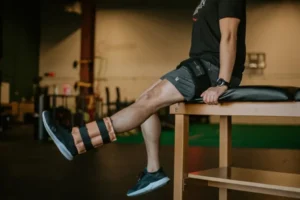
Call (239) 919-3510
Call (239) 919-3510

Sciatica is defined as pain in the low back, hip, or leg that is caused by compression of the sciatic nerve. This nerve is a large bundle that moves through the low back and into the back of the leg. While this compression can occur higher or lower on the nerve, patients generally describe pain both at the site of the issue as well as lower down the leg. This is referred to as radicular symptoms. Sciatic nerve pain usually occurs on one side of the body, as both nerves are rarely impacted at once. Other factors that may cause sciatica include a disc herniation or a pelvic misalignment. While there is a true definition of what sciatica is, many healthcare professionals will use the term as a “catch-all” for general low back type pains.
Many different factors may contribute to sciatica occurring. Sitting for an extended period of time, a lifting/twisting type injury, or a wear and tear problem in a disc or vertebrae are just some examples of how people begin to experience sciatica. Due to the vast origin of the issues, symptoms may be varied as well. Some people describe nerve symptoms such as numbness, tingling, or burning in the back of the leg or feet while others may describe a sharp pain in the low back or hip. These can range from very mild, dull discomforts to sharp pains that limit our tolerance for desired activities.
When a patient is dealing with sciatica, physical therapy can be a great avenue to alleviate pain and increase activity tolerance. Once an evaluation is performed, a physical therapist may use any combination of manual therapies such as soft tissue mobilization, stretching, strengthening, and/or mobility training to reduce pain, improve movement tolerance, and return to desired activities.
Soft tissue mobilization can be effective for pain reduction and improving tissue mobility. Many patients note improvements in their movements following this intervention. As the movement patterns become more “normalized”, pressures onto the sciatic nerve become lessened and less issues are present.
Stretching can also be an effective way to reduce pain and problems related to sciatica. Proper tissue length is vital for independence with mobility. If our muscles are tight, excessive strain is placed on the tissues. This limits our ability to move freely painfree and can cause pressure onto deeper structures, such as nerves.
Strengthening is an enormous part of dealing with sciatica. Most often, patients dealing with this condition identify weaknesses into the core and hip musculature. A good exercise program focusing on these areas can provide stability to the area. By increasing strength, stability becomes more present and stress/strain on structures effecting sciatica is minimized.
Gait training may also be an essential component of recovery from dealing with sciatic issues. Most people compensate by changing their gait pattern to avoid the pain. This places too much and/or too little stress on an area. Because the body is not used to these pressures, inflammation can result, placing stress onto the nerve.
While this is just a brief introduction to dealing with sciatica, it is always recommended to consult a physical therapy before beginning any part of a program described above. Since every person is not the same, each individual will present with their own unique set of issues to address. If you are dealing with sciatica, please reach out and let us know!
Email: Info@naplespremierpt.com
Phone: (239)919-3510
Website: www.Naplespremierpt.com